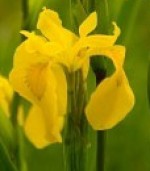 Also called water flag, this herbaceous perennial is a beardless rhizomatous iris native to the wetlands of Europe, western Asia and northwest Africa. It is a member of the iris family, Iridaceae, that also includes crocosmia, gladiolus, and Mexican shell flower. Plants grow 3-5′ tall and have gray-green sword like leaves with prominent mid-rib and bright yellow flowers. Four to twelve flowers appear on branched stalks in late spring to early summmer. Each flower is about 3-4″ across and has 3 upright petals and 3 petaloid sepals that droop downward and have darker yellow zone and brown or violet veining. The fruit is a several seeded dry capsule that is attractive in dried arrangements. Yellow flag thrives in wet lands but also does well in a border with moist soils where it is less vigorous and, therefore, less likely to become invasive. It spreads by seeds and rhizomes and can form large dense colonies that are difficult to remove once established. Yellow flag has been used in sewage treatment because it can remove heavy metals from the soil. Historically, preparations from the roots have been used as snuff, the flowers for dye, and the rhizomes as a laxative. The flowers are lovely in bouquets and were probably the model for the fleur de lis, the heraldic emblem of French kings in the 12th century. The genus name, Iris, honors the Greek goddess of the rainbow. The specific epithet, pseudacornus, comes from the Greek prefix pseudo meaning false, and a species Acornus, a grass like unrelated plant that has asimilar leaf.
Also called water flag, this herbaceous perennial is a beardless rhizomatous iris native to the wetlands of Europe, western Asia and northwest Africa. It is a member of the iris family, Iridaceae, that also includes crocosmia, gladiolus, and Mexican shell flower. Plants grow 3-5′ tall and have gray-green sword like leaves with prominent mid-rib and bright yellow flowers. Four to twelve flowers appear on branched stalks in late spring to early summmer. Each flower is about 3-4″ across and has 3 upright petals and 3 petaloid sepals that droop downward and have darker yellow zone and brown or violet veining. The fruit is a several seeded dry capsule that is attractive in dried arrangements. Yellow flag thrives in wet lands but also does well in a border with moist soils where it is less vigorous and, therefore, less likely to become invasive. It spreads by seeds and rhizomes and can form large dense colonies that are difficult to remove once established. Yellow flag has been used in sewage treatment because it can remove heavy metals from the soil. Historically, preparations from the roots have been used as snuff, the flowers for dye, and the rhizomes as a laxative. The flowers are lovely in bouquets and were probably the model for the fleur de lis, the heraldic emblem of French kings in the 12th century. The genus name, Iris, honors the Greek goddess of the rainbow. The specific epithet, pseudacornus, comes from the Greek prefix pseudo meaning false, and a species Acornus, a grass like unrelated plant that has asimilar leaf.
Type: Herbaceous perennial
Bloom: Yellow to cream flowers 3-4” across in mid-spring
Foliage: Long, narrow, sword-like leaves
Size: 3-5’ H x 2-3’ W
Light: Full sun to partial shade
Soil: Rich, wet to moist
Hardiness: Zones 4-9
Care: Control size if plant becomes invasive
Pests and Diseases: None of significance
Propagation: Seed, division in late summer to fall
Companion plants: Bog plants such as Venus fly trap, pitcher plant, sundew.
Outstanding Selections:
-
- ‘Berlin Tiger’ (yellow flowers with brown veining)
-
- ‘Crème de la Crème’ (white flowers)
- variegate (variegated foliage)
